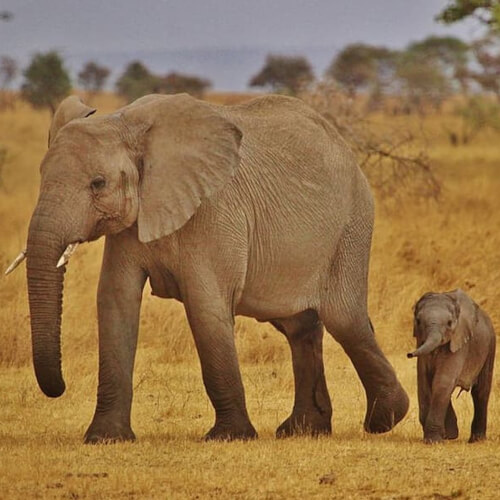



Elephants are mammals in the family Elephantidae, which includes three living species: the African bush elephant, the African forest elephant, and the Asian elephant.
All elephants have long trunks, tusks, large ears, thick legs, and tough grey skin. They are the largest living land species, with the largest African bush elephant on record measuring nearly 4 m (13 ft) tall, with a mass of 10,886 kg (24,000 lbs).
| Taxonomic Rank | Name | Common Name |
|---|---|---|
| Kingdom | Animalia | Animals |
| Phylum | Chordata | Vertebrates |
| Class | Mammalia | Mammals |
| Order | Proboscidea | Elephants and their extinct relatives |
| Family | Elephantidae | Elephants and Mammoths |
This ability has been observed in only a handful of other species, including humans, great apes (such as chimpanzees and orangutans), and dolphins. When presented with a mirror, elephants have been observed to investigate their own bodies and show behaviors suggesting they understand they're seeing their own reflections. This suggests a high level of self-awareness and cognitive ability in elephants.
Elephants have an interesting feature called the prepollex, a small, bony lump situated above their feet. For more than 300 years, its existence and classification as a toe (rather than a lump of cartilage) was debated. In 2011, researchers published an article in the scientific journal Science that confirms the "extra toe" and that it helps elephants support their enormous weight.
The sound and sting of bees can be quite bothersome to elephants. Elephants may become agitated or scared when they encounter bees or hear their buzzing.
Farmers in certain regions have actually used this knowledge by employing beehives as a natural deterrent to keep elephants away from their crops. The presence of beehives near fields or fences can help discourage elephants from approaching and causing damage. "Scare-elephant," anyone?
Elephants have a unique behavior known as "dust bathing" to cool themselves down and protect their skin. They throw dust, dirt, or sand onto their bodies using their trunks or by using their bodies to roll around in loose soil.
The dust acts as a barrier against the sun's rays, preventing direct exposure to their skin and helping to reduce the risk of sunburn. Additionally, the dust can also help repel insects and parasites, keeping the elephants more comfortable.
Because elephants often live in dry habitats, the ability to find water is essential. Using their trunks, elephants can detect the scent of water from long distances, even if it's kilometers away. Their trunks, which are like long noses, are highly sensitive and help them pick up these smells.
What's even more impressive is that elephants can even detect underground water. They use their trunks to explore the ground and pick up the scent of water that is hidden beneath the surface. This helps them locate hidden water sources, like underground springs or rivers.
African bush elephants are the heaviest land animals in the animal kingdom, with an average mass of a whopping 4,900 kg. Asian elephants come in 2nd, with an average mass of 4,150 kg, and African forest elephants in 3rd with an average mass of 2,700 kg. The white rhinoceros, which is 4th in line, comes in at about 2,000 kg on average—less than half of that of both the African bush and Asian elephants.
By comparison, a human pregnancy lasts less than half as long, at about 280 days. Female elephants usually have about 4 offspring in their lives of on average 60-70 years. When an elephant gives birth, the other elephants in the herd form a circle around her to protect her and her new baby from predators.